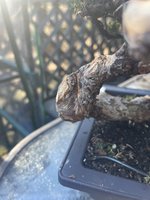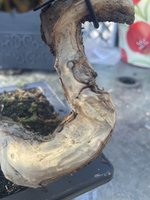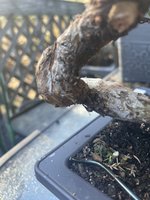You are using an out of date browser. It may not display this or other websites correctly.
You should upgrade or use an alternative browser.
You should upgrade or use an alternative browser.
Crack in trunk
- Thread starter Andre_J
- Start date
-
- Tags
- #damage help and care
WinstonWolfe
Yamadori
It appears the crack was only thought the deadwood. I wouldn't worry too much at this point.
aesthetically, you may want to ease the guy-wire and add some super glue/ gorilla glue to seal the crack and prevent water entry.
aesthetically, you may want to ease the guy-wire and add some super glue/ gorilla glue to seal the crack and prevent water entry.
WinstonWolfe
Yamadori
def more pictures, and also of the box. let the seller know, and perhaps they will offer up another solution. GL
Andre_J
Sapling
I already contacted the seller. We agreed on a partial refund. I don’t have more pics right now. I will post them later when I go home. The box had noticeable damage. It seems like it was dropped in transit.
Wires_Guy_wires
Imperial Masterpiece
If you see any live tissue that's damaged, I would use two tumb tacks and poke them on either sides of the break on the deadwood, and then tie those together with wire so that the live tissue can heal over the break.
Apply cut paste on the life tissue when the wounded sides touch, not before that.
Also, remove all guy wires that exert force from the top to the bottom of the tree because the force, no matter how small, will affect healing.
Junipers can callus over small wounds and breaks but you have to keep in mind that these breaks will never fully heal.
I've had a bunch of shipped trees in the past and the sellers usually made very sure that the tree was secured in the center of the box, wired or taped to a floor panel and with at least one hand-length away from the sides and the top of the box.
Apply cut paste on the life tissue when the wounded sides touch, not before that.
Also, remove all guy wires that exert force from the top to the bottom of the tree because the force, no matter how small, will affect healing.
Junipers can callus over small wounds and breaks but you have to keep in mind that these breaks will never fully heal.
I've had a bunch of shipped trees in the past and the sellers usually made very sure that the tree was secured in the center of the box, wired or taped to a floor panel and with at least one hand-length away from the sides and the top of the box.
rockm
Spuds Moyogi
Wrap a wire around the break point (not too tight, but tight enough to insure the split sides can't move). Better than that get a self-adhering sports wrap, coban or the like and wrap the trunk with that tightly to provide some support. The crack is (and will continue to be) a possible weak/break point for the trunk going forward.
Andre_J
Sapling
Thanks I’m trying to visualizeIf you see any live tissue that's damaged, I would use two tumb tacks and poke them on either sides of the break on the deadwood, and then tie those together with wire so that the live tissue can heal over the break.
Apply cut paste on the life tissue when the wounded sides touch, not before that.
Also, remove all guy wires that exert force from the top to the bottom of the tree because the force, no matter how small, will affect healing.
Junipers can callus over small wounds and breaks but you have to keep in mind that these breaks will never fully heal.
I've had a bunch of shipped trees in the past and the sellers usually made very sure that the tree was secured in the center of the box, wired or taped to a floor panel and with at least one hand-length away from the sides and the top of the box.
Interesting idea. I have all the materials so I may tryIf you see any live tissue that's damaged, I would use two tumb tacks and poke them on either sides of the break on the deadwood, and then tie those together with wire so that the live tissue can heal over the break.
Apply cut paste on the life tissue when the wounded sides touch, not before that.
Also, remove all guy wires that exert force from the top to the bottom of the tree because the force, no matter how small, will affect healing.
Junipers can callus over small wounds and breaks but you have to keep in mind that these breaks will never fully heal.
I've had a bunch of shipped trees in the past and the sellers usually made very sure that the tree was secured in the center of the box, wired or taped to a floor panel and with at least one hand-length away from the sides and the top of the box.
doing that. I would have never thought to use thumb tacks and wire. So I should only cover the small area where the deadwood and live part of tree meet with paste and not the entire crack?If you see any live tissue that's damaged, I would use two tumb tacks and poke them on either sides of the break on the deadwood, and then tie those together with wire so that the live tissue can heal over the break.
Apply cut paste on the life tissue when the wounded sides touch, not before that.
Also, remove all guy wires that exert force from the top to the bottom of the tree because the force, no matter how small, will affect healing.
Junipers can callus over small wounds and breaks but you have to keep in mind that these breaks will never fully heal.
I've had a bunch of shipped trees in the past and the sellers usually made very sure that the tree was secured in the center of the box, wired or taped to a floor panel and with at least one hand-length away from the sides and the top of the box.
Wires_Guy_wires
Imperial Masterpiece
It would not make sense to put paste on the deadwood because it can't grow and heal. You use cut paste to help living wounds get favorable healing conditions.So I should only cover the small area where the deadwood and live part of tree meet with paste and not the entire crack?
As for the thumb tacks, make sure you put those on the side where the crack is the widest, and just pull the wire together until the crack closes.
The wire is to keep it in place while it heals. Like a stitch over a wound. Just make absolutely sure you don't tear the live part open during this operation. Use caution and go slow.
Now you could potentially glue the deadwood shut and re-enforce it like that, but that can leave a mark.
Andre_J
Sapling
It an odd crack. The tree still seems very sturdy. I tried super glueing and It barely moved when I tried closing the crack.It would not make sense to put paste on the deadwood because it can't grow and heal. You use cut paste to help living wounds get favorable healing conditions.
As for the thumb tacks, make sure you put those on the side where the crack is the widest, and just pull the wire together until the crack closes.
The wire is to keep it in place while it heals. Like a stitch over a wound. Just make absolutely sure you don't tear the live part open during this operation. Use caution and go slow.
Now you could potentially glue the deadwood shut and re-enforce it like that, but that can leave a mark.
Attachments
WinstonWolfe
Yamadori
It doesn't appear to have damaged the live vein at all. You should be good. Let it rest.It an odd crack. The tree still seems very sturdy. I tried super glueing and It barely moved when I tried closing the crack.
Also, if you add your location to your profile, it can be very helpful when giving advice in the future.
Andre_J
Sapling
Thanks. I will do that.It doesn't appear to have damaged the live vein at all. You should be good. Let it rest.
Also, if you add your location to your profile, it can be very helpful when giving advice in the future.
19Mateo83
Masterpiece
If the crack is only in the dead wood and you can get it to close back together, I would try a small amount of a water soluble wood glue (tight bond 3 works well). Apply it neatly inside the crack then clamp/wrap it tightly. Clean up any squeeze out or drips with a wet rag. Let it dry overnight. If the crack lined back up and you had good contact and clamping pressure the glue joint will be stronger than the surrounding wood.
Similar threads
- Replies
- 17
- Views
- 2K
- Replies
- 13
- Views
- 1K




